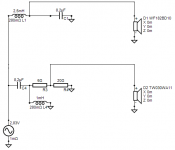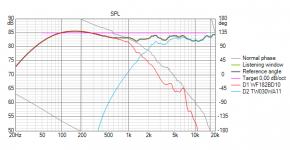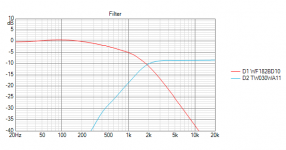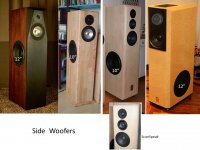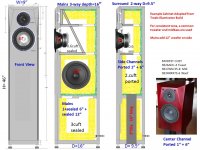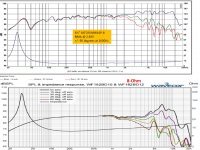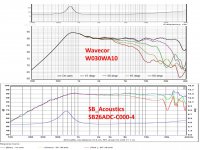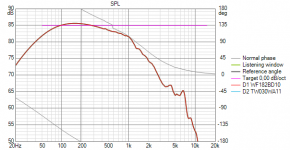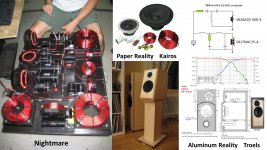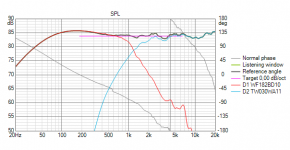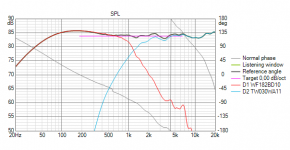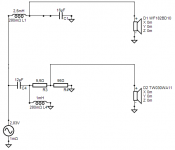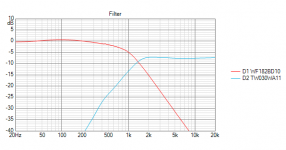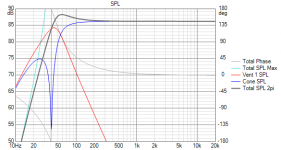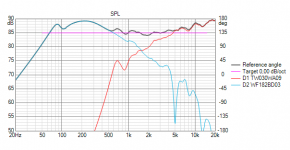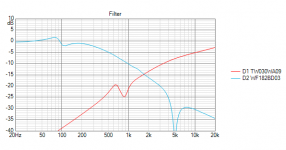I want to build my first diy speakers using a 2 way design and simple second order crossover. Why 2 way little speakers?
My listening room is not huge, so don't need really big ones.
I can't use loud bass because disturbing/shaking next door people. Finally also the "wife" don't want monster speakers and my listening preferences are not related to big-boomy bass at all.
I'm also starting the path to build a Master's Nelson Pass clone (the old Aleph 3+27), so not huge power, only pure 30 watts in class A (if God bless me letting me finalizing everything).
I'm sharing my first newbie insights and thoughts before proceed with the purchase of speaker components. I'm sure I can get some advice from seasoned speaker builders, advice on things I'm not aware.
My budget is limited, so my first decision was to use Wavecor drivers, cost contained but seems to be good ones, easily found in the European diy market and widely used as OEM speaker parts. The web page is also full of information.
First step.
In order to get some insights and inspiration I looked into different existent speaker kits using Wavecor drivers, having full information on the web, for example:
Wavemon 182, ported, using tweetter TW030WA09 + Mid-woofer WF182BD03
WaveMon 182
(I runned a simulation for this one too)
Loire Top, sealed, using tweetter TW030WA10 + Mid woofer WF182BD12
Loire Top
CSS Criton 1TD, ported, using tweeter TW022WA04 + Mid-woofer WF182BD10
SHOP | css-audio
Later I found a freeware Loudspeaker Simulator named VituixCAD by a genius guy named Kimmo Sauristo, and also found all the datasheets and full specs for simulation in the Wavecor page:
Database
After revising these above and other diy projects, and having all this in my mind, I selected the drivers with which I would like to bulild the speakers:
The Wavecor tweeter TW030WA11 and the midwoofer WF182BD10
TW030WA11_12
http://www.wavecor.com/html/wf182bd09_10_11_12.html
Found the midwoofer having interesting specs (low Fs and good overall characteristics) and being highly appreciated by many builders/listeners.
The tweeter was selected because the specs seems to be very fine compared to other Wavecor items. Selection was most a matter of intuition than deep knowledge.
As said, with full specs in hand (as found in the Wavecor web page), and after calculating a first voltage divider for the tweeter and selecting first filter values running on-line calculators, then I began to make many adjustments (playing up and down with capacitor, resistor and inductance values) with VituixCAD (was a very interesting experience with this marvelous tool) and got final setup..
The results are in the photos attached to this thread.
One photo shows the very simple crossover and component values, other the SPL simulation result with tweeter inverted phase/polarity and finally the filter graph showing a cross point at approx. 1898 Hz (this is not a problem for the tweeter, having a very low Fs of 410 Hz).
My question to any seasoned speaker diyer:
To me (a newbie) the results as per the photos seems to be fine. They reflect the drivers frequency and impedance bahavior. Is this trustable or I'm missing something?
Then.
My plan is to build a ported enclosure (not yet decided) between 15 and 17 liters, Fb between 37-39 Hz and F3 between 40-42 Hz. I know this will modify the SPL frequency response, but only in the lower first octave. I guess the results of the freq. response in the medium-upper register will not be affected.
Any thougts or advise?
I'm on a good road?
My listening room is not huge, so don't need really big ones.
I can't use loud bass because disturbing/shaking next door people. Finally also the "wife" don't want monster speakers and my listening preferences are not related to big-boomy bass at all.
I'm also starting the path to build a Master's Nelson Pass clone (the old Aleph 3+27), so not huge power, only pure 30 watts in class A (if God bless me letting me finalizing everything).
I'm sharing my first newbie insights and thoughts before proceed with the purchase of speaker components. I'm sure I can get some advice from seasoned speaker builders, advice on things I'm not aware.
My budget is limited, so my first decision was to use Wavecor drivers, cost contained but seems to be good ones, easily found in the European diy market and widely used as OEM speaker parts. The web page is also full of information.
First step.
In order to get some insights and inspiration I looked into different existent speaker kits using Wavecor drivers, having full information on the web, for example:
Wavemon 182, ported, using tweetter TW030WA09 + Mid-woofer WF182BD03
WaveMon 182
(I runned a simulation for this one too)
Loire Top, sealed, using tweetter TW030WA10 + Mid woofer WF182BD12
Loire Top
CSS Criton 1TD, ported, using tweeter TW022WA04 + Mid-woofer WF182BD10
SHOP | css-audio
Later I found a freeware Loudspeaker Simulator named VituixCAD by a genius guy named Kimmo Sauristo, and also found all the datasheets and full specs for simulation in the Wavecor page:
Database
After revising these above and other diy projects, and having all this in my mind, I selected the drivers with which I would like to bulild the speakers:
The Wavecor tweeter TW030WA11 and the midwoofer WF182BD10
TW030WA11_12
http://www.wavecor.com/html/wf182bd09_10_11_12.html
Found the midwoofer having interesting specs (low Fs and good overall characteristics) and being highly appreciated by many builders/listeners.
The tweeter was selected because the specs seems to be very fine compared to other Wavecor items. Selection was most a matter of intuition than deep knowledge.
As said, with full specs in hand (as found in the Wavecor web page), and after calculating a first voltage divider for the tweeter and selecting first filter values running on-line calculators, then I began to make many adjustments (playing up and down with capacitor, resistor and inductance values) with VituixCAD (was a very interesting experience with this marvelous tool) and got final setup..
The results are in the photos attached to this thread.
One photo shows the very simple crossover and component values, other the SPL simulation result with tweeter inverted phase/polarity and finally the filter graph showing a cross point at approx. 1898 Hz (this is not a problem for the tweeter, having a very low Fs of 410 Hz).
My question to any seasoned speaker diyer:
To me (a newbie) the results as per the photos seems to be fine. They reflect the drivers frequency and impedance bahavior. Is this trustable or I'm missing something?
Then.
My plan is to build a ported enclosure (not yet decided) between 15 and 17 liters, Fb between 37-39 Hz and F3 between 40-42 Hz. I know this will modify the SPL frequency response, but only in the lower first octave. I guess the results of the freq. response in the medium-upper register will not be affected.
Any thougts or advise?
I'm on a good road?
Attachments
Last edited:
Digging in the Wavecor web page, I found a year 2014 complete developed project using the same midwoofer, the "Loire Top" speaker, built in a closed or sealed box, showing graphs that for me are surprisingly awesome, if we trust the measurements.
Here's the link.
https://www.wavecor.com/Construction_-_Loire_Top.pdf
This speaker also gives the opportinity to add a subwoofer later, also completely designed in another article.
I'm not able to find the complete set of data to run a detailed simulation for the tweeter used in the "Loire Top", so I have only the data for the midwoofer.
Will try to replace with another tweeter and see what simulation results come out, but I don't like the R-C-L additional filtering added to "correct" some unwanted responses.
Anyone has built this speaker and knows the results?
Here's the link.
https://www.wavecor.com/Construction_-_Loire_Top.pdf
This speaker also gives the opportinity to add a subwoofer later, also completely designed in another article.
I'm not able to find the complete set of data to run a detailed simulation for the tweeter used in the "Loire Top", so I have only the data for the midwoofer.
Will try to replace with another tweeter and see what simulation results come out, but I don't like the R-C-L additional filtering added to "correct" some unwanted responses.
Anyone has built this speaker and knows the results?
I have looked in to different kits with Wavecor drivers as well, I found a company in Denmark that has several kits with these drivers.
This one might be closest to yours, only difference is that it uses WF182BD09 (4Ohm) for low frequency, and it's two 1:st order filters instead.
WA7-Supreme - Byggesæt Stander - FreQuence.dk
This one might be closest to yours, only difference is that it uses WF182BD09 (4Ohm) for low frequency, and it's two 1:st order filters instead.
WA7-Supreme - Byggesæt Stander - FreQuence.dk
Thanks PSA78
It's the same pair of drivers, as you said, except for the midwooker impedance. Nice to see that this pair of drivers produce satisfactory results for other people. Encouraging.
Best
It's the same pair of drivers, as you said, except for the midwooker impedance. Nice to see that this pair of drivers produce satisfactory results for other people. Encouraging.
Best
I think you'll like the result if you do it right, I've used a couple of Wavecor drivers and found them excellent.
re:'I don't like the R-C-L additional filtering" = the WF182BD10 has a response peak which needs taming, so you'll need at least one RCL filter
(Datasheet here: WF182BD09_10_11_12 )
re:'I don't like the R-C-L additional filtering" = the WF182BD10 has a response peak which needs taming, so you'll need at least one RCL filter
(Datasheet here: WF182BD09_10_11_12 )
jdamico, From the Nelson Pass Aleph 3 datasheet, your 30-watt amp would favor a speaker with ~6-8 ohm impedance. BUT in your small room a 3-4ohm speaker load should not make heavy demands. BUT I would still favor using 8-ohm drivers(Re ~6ohms) if I owned the Aleph 3.
Distortion (1KHz)
0.2% @ 30 watts, 8 ohms
1% @ 60 watts, 4 ohms
1% @ 60 watts, 2 ohms
The woodshop capability often sets the design direction.
You could build a low edge diffraction 2-way cabinet and use a stand, or just put them on your furniture.... but...
In one trip to the woodshop you could cut the panels for a FUTURE 3-way floor-standing speaker cabinet designed for a sealed side woofer & sealed midbass, and today build-in just a proven 2-way with a 6.5" ported midbass plus 1" dome. Example attached. Hearing science shows benefits of ~1,700Hz crossover.
Distortion (1KHz)
0.2% @ 30 watts, 8 ohms
1% @ 60 watts, 4 ohms
1% @ 60 watts, 2 ohms
The woodshop capability often sets the design direction.
You could build a low edge diffraction 2-way cabinet and use a stand, or just put them on your furniture.... but...
In one trip to the woodshop you could cut the panels for a FUTURE 3-way floor-standing speaker cabinet designed for a sealed side woofer & sealed midbass, and today build-in just a proven 2-way with a 6.5" ported midbass plus 1" dome. Example attached. Hearing science shows benefits of ~1,700Hz crossover.
Attachments
'I don't like the R-C-L additional filtering" = the WF182BD10 has a response peak which needs taming, so you'll need at least one RCL filter.
PeteMcK has identified both a cost consideration and a sound quality consideration: For passive crossover designs, can we find a more expensive, higher sound quality driver which does not require one or two R-L-C type filters? Spend your money on better drivers which do not require SPL tuning instead of the passive R + L + C components. The popular Kairos uses Satori drivers with just 2*L & 2*C & 2*R passive components, as do stepped baffle designs with the same drivers. There are a few 2-ways using textbook BW3 & BW3 circuits.
===2===2===2===
A few speaker experts recommend paper cone drivers over aluminum cone or ceramic cone for small listening rooms which have very little room treatment = rugs, drapes, soft fabric furniture, etc.... Anyone study this?
Attachments
the Wavecor WF160WA02 is cheaper (pressed frame), although smaller..., yet easy to crossover, 1st order is OK, perhaps use a pair? I'm using a pair in my main 3.5 way system for the low mids, sounds wonderful....
I think you'll like the result if you do it right, I've used a couple of Wavecor drivers and found them excellent.
re:'I don't like the R-C-L additional filtering" = the WF182BD10 has a response peak which needs taming, so you'll need at least one RCL filter
(Datasheet here: WF182BD09_10_11_12 )
Many thanks for your advise PeteMcK
If I'm understanding right, the WF182BD10 nasty peak is that between 5kHz and 10kHz, but at such high frequencies (please correct me if I'm wrong) the simple lowpass filter shall do the job.
I'm attaching the WF182BD10 frequency response after the 2nd order lowpass, and the peak is still visible but appears to be very attenuated. Do you think is still a problem?
There is another little peak at 1kHz, but with less than 1 dB effect, and not know sure if this will cause trouble.
Thanks again
Attachments
the Wavecor WF160WA02 is cheaper (pressed frame), although smaller..., yet easy to crossover, 1st order is OK, perhaps use a pair? I'm using a pair in my main 3.5 way system for the low mids, sounds wonderful....
Will check the WF160WA02. Thanks.
jdamico, From the Nelson Pass Aleph 3 datasheet, your 30-watt amp would favor a speaker with ~6-8 ohm impedance. BUT in your small room a 3-4ohm speaker load should not make heavy demands. BUT I would still favor using 8-ohm drivers(Re ~6ohms) if I owned the Aleph 3.
Distortion (1KHz)
0.2% @ 30 watts, 8 ohms
1% @ 60 watts, 4 ohms
1% @ 60 watts, 2 ohms
The woodshop capability often sets the design direction.
You could build a low edge diffraction 2-way cabinet and use a stand, or just put them on your furniture.... but...
In one trip to the woodshop you could cut the panels for a FUTURE 3-way floor-standing speaker cabinet designed for a sealed side woofer & sealed midbass, and today build-in just a proven 2-way with a 6.5" ported midbass plus 1" dome. Example attached. Hearing science shows benefits of ~1,700Hz crossover.
Thanks, LineSource,
My objective is towards 8 ohms and that's the reason I'm chosing an 8 ohm woofer.
On the other hand, my plan is simple MDF cutted at the same time of buying (in shop), then will think about finishing options. Fortunately I like woodworks and made a few furniture and repairs before, so feel confident.
I do like crossover lower crossing points because more "in phase" and coherent result in the middle-highs, but like everithing, I guess is a matter of compromise considering dispersion and the risk of tweeter overheating.
Best
Will check the WF160WA02. Thanks.
I found only the WF168WA02 (maybe a typo) and at a first glance the specs seems to be very nice. Being smaller still have a larger effective radiating area than his big brother WF182BD10 and is less than a half the price…
Maybe two of these working in parallel could be an alternative solution.
WF168WA01_02
Hi: The WF160WA02 is out of production, I believe.
Have you looked at the 15W/8424G00 or 18W/8424G00 from ScanSpeak's Discovery range?
Have you looked at the 15W/8424G00 or 18W/8424G00 from ScanSpeak's Discovery range?
If I'm understanding right, the WF182BD10 nasty peak is that between 5kHz and 10kHz, but at such high frequencies (please correct me if I'm wrong) the simple lowpass filter shall do the job.
The "Lorie" design team believed that three L-R-C filters plus a tweeter 'lift RC' were necessary to support LR2 crossover circuits with the Wavecor WF182BD12 & TW030WA10. If you build the Lorie, would you purchase and use this crossover?
Final crossover simulations typically include:
-baffle size/shape effects
-baffle edge diffraction effects
-room placement effects
Then measure outside... measure at listener position... FINAL SIM
bevels or rounds... bevels or rounds... bevels or rounds...
Treat your edges well and they will treat your ears well. 🙂
Attachments
Yes, LineSource, maybe you're right.
I don't have the measurement tools to do such a trial-error kind of design by myself.
😕
Maybe I should try to build a proven kit...
The Kairos seems to be very good speakers and to fit my needs in terms of space and listening preferences.
Do you have them, or do you have listen to them?
(I just want to have some higher level of ceirtainty… 🙂 )
Regarding the Loire. These german guys like to correct everything with all kind of filtering. I don't blame them, because I'm sure they know a lot more than me about speakers, but this kinda coctel of capacitors and inductances nearly eliminates any trace of phase coherence to me….
Back to the Kairos. I've seen the kit (pair) at Meniscus costing about $764. In the meanwhile my BOM for the Wavecor's kit (pair) is raising the 600 Euros. They are not so far away, but I don't know enough about the Jeff Bagby design (the Kairos), and would like to have more information, if possible.
Thanks for your time
I don't have the measurement tools to do such a trial-error kind of design by myself.
😕
Maybe I should try to build a proven kit...
The Kairos seems to be very good speakers and to fit my needs in terms of space and listening preferences.
Do you have them, or do you have listen to them?
(I just want to have some higher level of ceirtainty… 🙂 )
Regarding the Loire. These german guys like to correct everything with all kind of filtering. I don't blame them, because I'm sure they know a lot more than me about speakers, but this kinda coctel of capacitors and inductances nearly eliminates any trace of phase coherence to me….
Back to the Kairos. I've seen the kit (pair) at Meniscus costing about $764. In the meanwhile my BOM for the Wavecor's kit (pair) is raising the 600 Euros. They are not so far away, but I don't know enough about the Jeff Bagby design (the Kairos), and would like to have more information, if possible.
Thanks for your time
What I'm seeing is that the resonance trap is needed. The breakup is only -20dB in your lowpass sim. This is not enough, and -25dB should be the bare minimum, whereas -40dB should be the norm, and -50dB is eliminated completely. Trust me, it will be audible at -20dB. Maybe not in output, but in HD and how the driver sounds.
Phase coherence is related the resultant FR, not mainly the circuit used, but a combination of the variances in the inherent FR of the driver and the transfer function of the circuit used. More parts is not necessarily a bad thing. "Minimalism with respect to necessity."
Now- the Loire looks to be bright on the top, and I would not favor it as it is depicted. Flat response would be better. The notches on the woofer help with the bump below the xover and the breakup. I feel these are required, but might be okay using a different filter to accomplish the same end-goal. The tweeter response has an LCR attached to lower the output in its lower range and leave the top-end untouched. I woud still add a 3-6 ohm resistor out front to attenuate it to match the midbass.
Later,
Wolf
Phase coherence is related the resultant FR, not mainly the circuit used, but a combination of the variances in the inherent FR of the driver and the transfer function of the circuit used. More parts is not necessarily a bad thing. "Minimalism with respect to necessity."
Now- the Loire looks to be bright on the top, and I would not favor it as it is depicted. Flat response would be better. The notches on the woofer help with the bump below the xover and the breakup. I feel these are required, but might be okay using a different filter to accomplish the same end-goal. The tweeter response has an LCR attached to lower the output in its lower range and leave the top-end untouched. I woud still add a 3-6 ohm resistor out front to attenuate it to match the midbass.
Later,
Wolf
-25dB should be the bare minimum, whereas -40dB should be the norm, and -50dB is eliminated completely. Trust me, it will be audible at -20dB. Maybe not in output, but in HD and how the driver sounds
Okey, capito.
Many Thanks
After just "playing" here and there with the crossover values in the simulator, I realized that i'ts possible to attenuate more the woofer "breakup" by lowering the crossing point (a more severe lowpass for the woofer). This adds some extra solicitation to the tweeter too, but having this tweeter low resonance Fs=410 Hz, I think this sould be not a problem.
I'm sharing the new plots for the Wavecor driver's crossover, one pure and another with 1/6 octave smoothing. Everything seems to be more or less in the +/- 1,5 dB SPL response 🙂
Also I'm sharing the new crossover values, the filter graph and a potential vented enclosure SPL behavior.
Thanks to all
I'm sharing the new plots for the Wavecor driver's crossover, one pure and another with 1/6 octave smoothing. Everything seems to be more or less in the +/- 1,5 dB SPL response 🙂
Also I'm sharing the new crossover values, the filter graph and a potential vented enclosure SPL behavior.
Thanks to all
Attachments
I found another project on the web using Wavecor drives.
https://www.hifisound.de/out/media/.../XwST3ZSunAfsutBEcDR0uisCVu7LUjr4fSDwHA==.pdf
Wavemon 182 was designed by Bernd Timmermanns and was published in a german magazine (unfortunately I do not speak german).
The interesting thing is that for this drivers the complete data for crossover simulation is available at Wavecor web page, so I ran a simulation to compare my results vs. the measurements shown in the magazine.
Attached my sim results. Only inverting tweeter polarity I could obtain something similar to a flat response. In the magazine the designer inverts woofer polarity (don't know why). Nevertheless the simulation is far from a perfect response and reflects some nasty bumps. 😕
https://www.hifisound.de/out/media/.../XwST3ZSunAfsutBEcDR0uisCVu7LUjr4fSDwHA==.pdf
Wavemon 182 was designed by Bernd Timmermanns and was published in a german magazine (unfortunately I do not speak german).
The interesting thing is that for this drivers the complete data for crossover simulation is available at Wavecor web page, so I ran a simulation to compare my results vs. the measurements shown in the magazine.
Attached my sim results. Only inverting tweeter polarity I could obtain something similar to a flat response. In the magazine the designer inverts woofer polarity (don't know why). Nevertheless the simulation is far from a perfect response and reflects some nasty bumps. 😕
Attachments
How about showing the phase of the individual drivers with xover applied, please? How about plots of impedance, imp/phase, and individual impedances with xover applied as well?
You just are not showing us all of the information.
Wavecor TW030WA11 | HiFiCompass
I would not xover below 1.5kHz with this tweeter to keep the 3rd order down. You will also find that this waveguided tweeter is not that easy to tame and keep happy without the dreaded honk coming through. I've heard it 3 times, and one of 3 got it right, all by experienced builders. Several others have said they could not succeed and be happy with it.
Good luck!
Wolf
You just are not showing us all of the information.
Wavecor TW030WA11 | HiFiCompass
I would not xover below 1.5kHz with this tweeter to keep the 3rd order down. You will also find that this waveguided tweeter is not that easy to tame and keep happy without the dreaded honk coming through. I've heard it 3 times, and one of 3 got it right, all by experienced builders. Several others have said they could not succeed and be happy with it.
Good luck!
Wolf
- Home
- Loudspeakers
- Multi-Way
- Starting my 1st diy speaker project, a simple 2 way with Wavecor drivers
